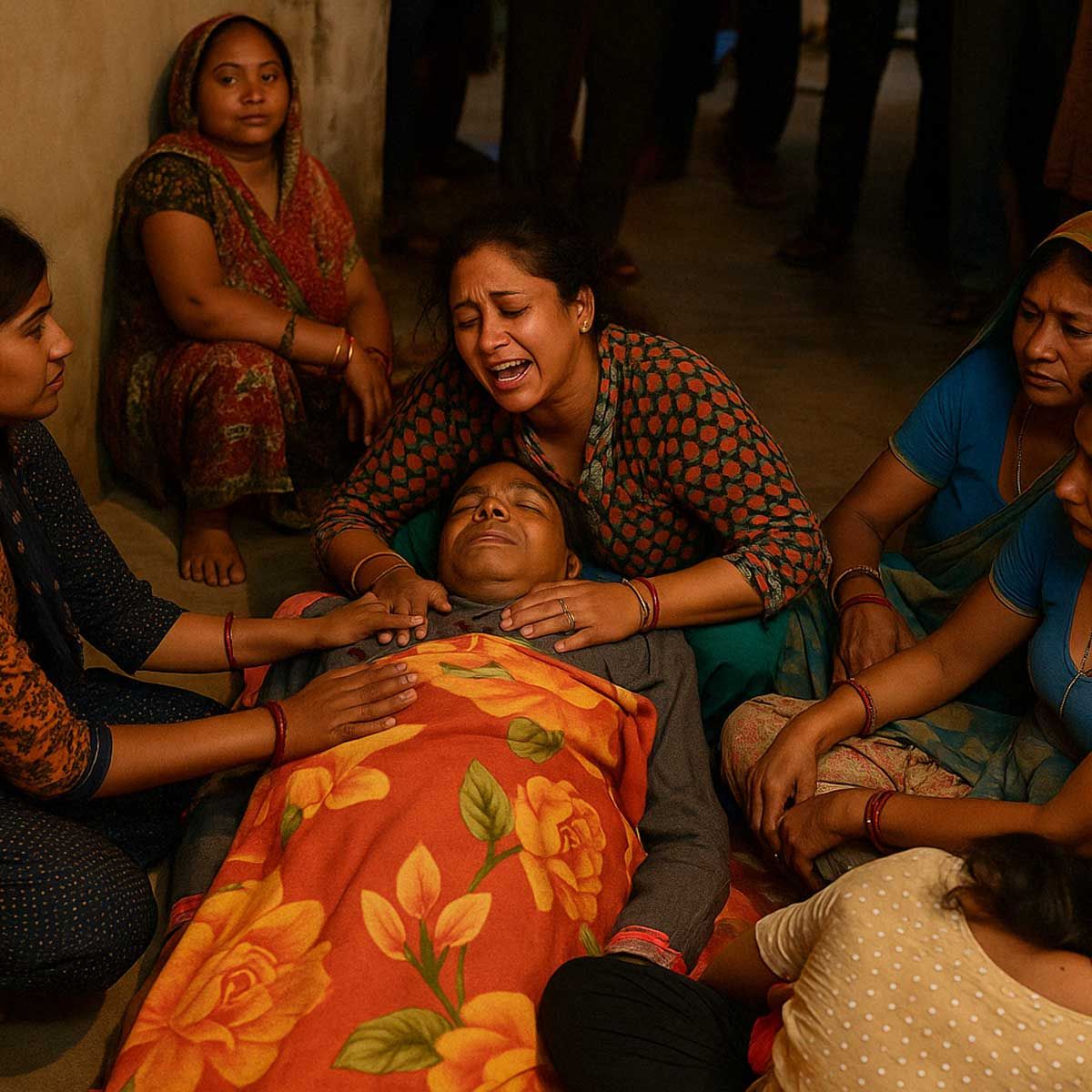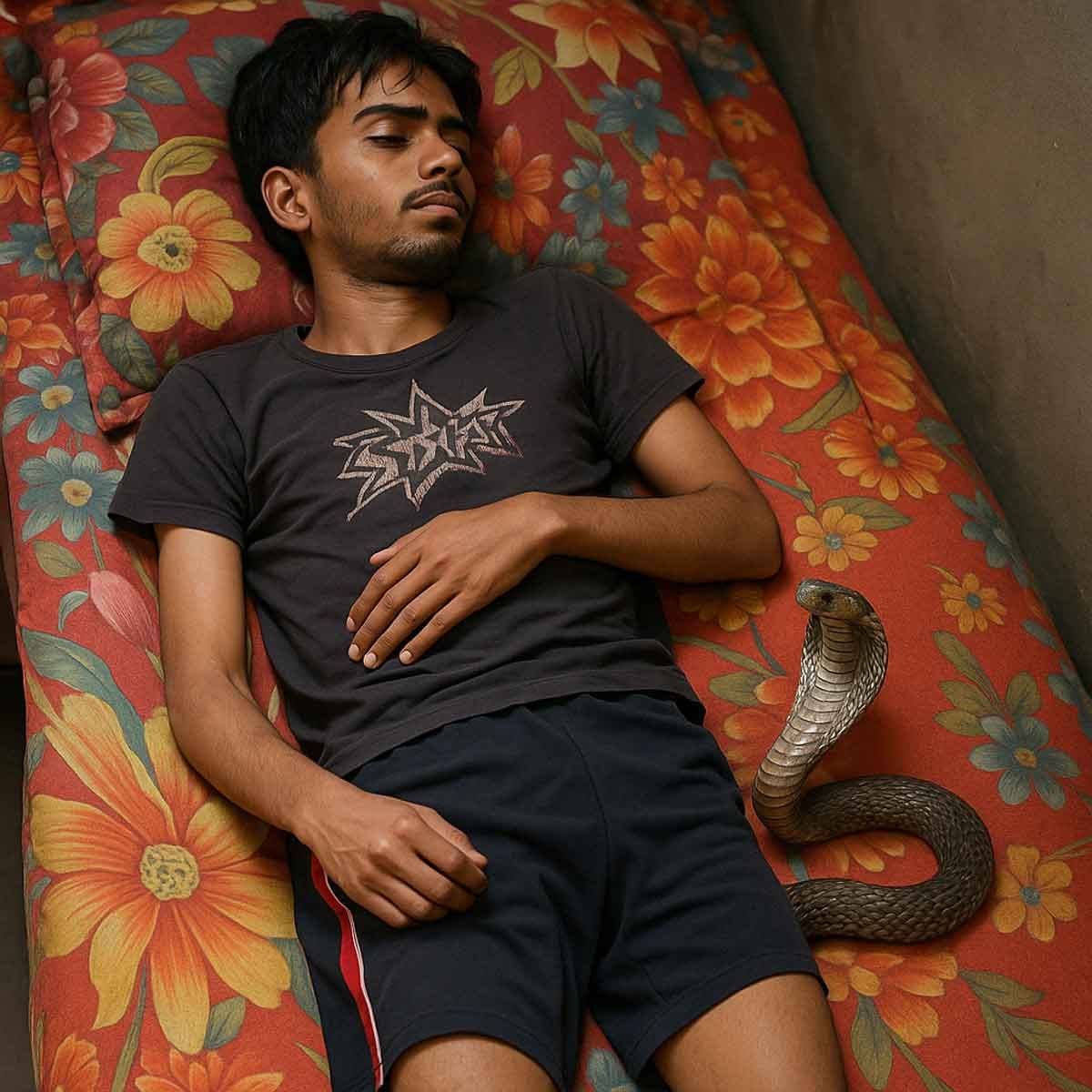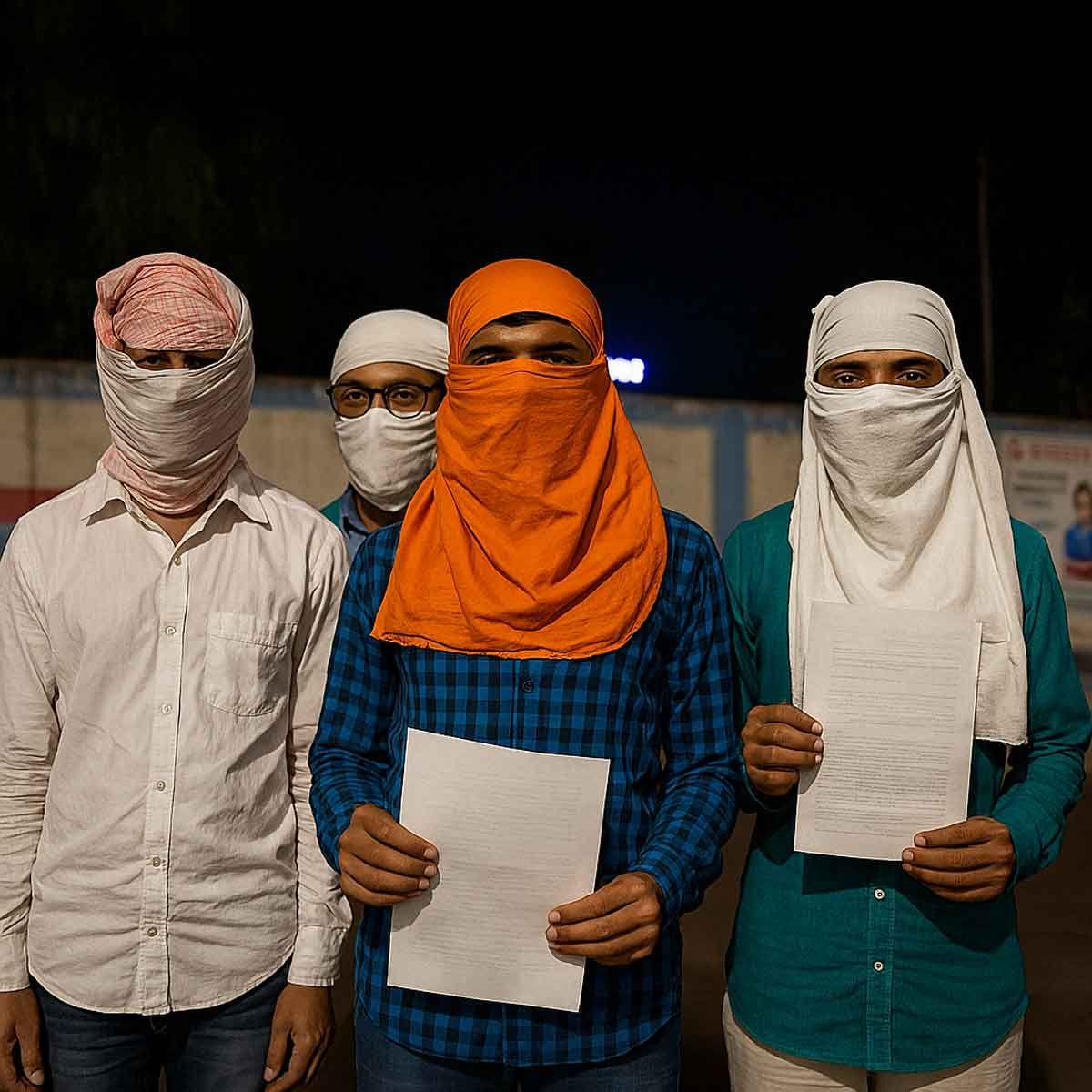More Coverage
Twitter Coverage
Satyaagrah
Written on
Satyaagrah
Written on
Satyaagrah
Written on
Satyaagrah
Written on
Satyaagrah
Written on
JOIN SATYAAGRAH SOCIAL MEDIA
"In every brushstroke, a story unfolds": Amadubi, a vibrant canvas where nature's colors meet tribal artistry, earthy hues tell tales of ages, and every handcrafted piece echoes generations of tradition, dive into this treasure to feel the pulse of Bharat

Tucked away amidst the natural splendor of Jharkhand is Amadubi, a village that is more than just a geographical location; it's a living museum. As you walk through its pathways, the village reveals a canvas of vibrant Paitkar Scroll Paintings, one of India’s oldest tribal art forms, dating back centuries.
|
Imagine a place where trees and leaves become canvases. That’s Amadubi for you. Every brushstroke narrates legends, every color sings myths, and every painting whispers tales from a time long gone. Housing over 50 families, each with a story of its own, this village is a repository of dreams, passion, and unparalleled talent.
Most tourists find themselves on a delightful journey, moving from one art home to another, uncovering layers of history, spirituality, and creativity. These are not just paintings; they're soulful narratives painted with devotion, echoing the vibrant stories of mythology, epic battles, and legends.
Situated just a stone's throw from the bustling city of Jamshedpur, this rural idyll comes alive with melodies that accompany the scrolls of paintings. Each rendition, whether it be of wars, nature, or festivals, transports you to a different world, thanks to the incredible talents of the community of artist-performers.
In the heart of the village, under the soothing shade of a palash tree, we meet Vijay Chitrakar, a revered figure amongst the artists. His artistry isn’t just about the physical act of painting; it's a spiritual journey. As he channels his inner emotions, singing odes to deities, like Durga, the air becomes thick with reverence. His Pyatkar scroll painting, which he unravels in tandem with his song, leaves onlookers spellbound. Such is the magic of Amadubi.
Amadubi's geographical placement in the East Singhbhum district adds to its charm. Being a hub for some of Jharkhand's most skilled ethnic artists, the village is a beacon for art lovers worldwide. Around 54 Chitrakar families reside here, each home a studio where the past and present coalesce. Scenes from epics, folklore, and everyday village life are painted with finesse on leaves and barks of trees. This art form isn't just for the eyes but also for the soul, providing a sense of continuity in a rapidly changing world.
Rewinding time, we learn that the regions of Bihar, Bengal, and Odisha were once the epicenters for nomadic artists called Chitrakars. Their unique art, Paitkar, showcased on Paat (scrolls of cloth or tree bark), was a harmonious blend of visual and vocal storytelling. The process of creating each piece was meditative. They'd focus on a mythological narrative, visualizing it in its entirety before immortalizing it using mineral and vegetable hues, all sourced naturally.
|
These wandering minstrels, with their scrolls and songs, had an essential spiritual role. The Santhals, a native tribal group, believed that the soul's path to the afterlife was paved only when the Chitrakars painted the deceased's eyes on the canvas. This poignant blend of art and belief signifies the depth of connection the art form has with life, death, and the divine.
Fast forward to today, these art forms have evolved. While maintaining their roots, the paintings now encapsulate rural socio-economic scenes, festivals, and agricultural practices. A night in Amadubi could mean witnessing a marathon of performances, with scrolls stretching meters, tales unfolding, and songs echoing under the moonlit sky.
But the village offers more than just art. Tribal hunters, local festivities, bonfires, and barbecues paint a vivid picture of daily life. Tourists can stay in traditional huts, made of mud, bamboo, and wood, named after indigenous trees. Each structure, adorned with hand-painted motifs, pays homage to the region's artistic heritage.
The Gurukul or workshop is a hub of learning where the art forms get a modern twist. Women learn block printing, incorporating Pyatkar motifs into Kantha embroidery, further testament to the village's adaptive spirit. A museum showcases traditional instruments, hinting at the musical legacy of the region.
Culinary enthusiasts can rejoice too. Dining in Amadubi is a gourmet experience, with local delicacies served on bronze platters. Every bite of the ud pitha or zil pitha isn't just food; it's a taste of history.
To sum it up, Amadubi isn't just a destination; it’s an emotion. Every visit is a step back in time, an ode to India's rich artistic and cultural tapestry.
|
Amadubi: An Eloquent Testimony of Timeless Art and Culture
While many travelers earmark Amadubi as a brief sojourn from Jamshedpur, the richness of the experience warrants a longer stay. This village doesn't merely offer a glimpse of rural India, but it immerses visitors into the rhythm and life from epochs preceding the rise of India’s first 'Steel City'. Our mornings began with the melodic calls of peacocks echoing in the crisp air. As the sun rose, we embarked on captivating journeys to the neighboring Santhal and Oraon tribal settlements. Here, we witnessed the intricacies of daily life: men diligently tilling the fields, women gracefully sieving grain, and young boys crafting intricate trinkets from bamboo and blooms. Santhali girls, meanwhile, adorned their homes in vibrant hues and patterns, eagerly preparing for Sarhul, the spring festival. The homes, while humble, boasted vivid geometric patterns on their walls, accentuated with shimmering mirrors, fragments of bangles, and gleaming discarded CDs.
This corner of India isn't just about the present but bears witness to the significant chapters of history. Here, WWII-era airstrips in Dhalbhumgarh and Chakulia stand as remnants of the past. The temples of Trivineshwar and Dasbhuja at Rajbari whisper tales of the ancient Rajas of Dhalbhumgarh. The revered Rankini Mandir of Jadugoda and the picturesque Ghatshila hills, where the renowned Bengali writer Bibhuti Bhushan Bandyopadhaya took his first breath, further illustrate the region's rich cultural fabric. Deep within the forest, an animistic shrine buzzed with activity. Tribal men assembled, brewing handiya (a traditional rice beer), as offerings to ancestral spirits and tribal gods. Surrounding trees were adorned with straw effigies of animals, signaling the onset of a joyous celebration.
Upon our return to Jamshedpur, our hunger for art led us to purchase more Pyatkar art, intricate dokra crafts, vibrant Mithila paintings, and captivating masks from Biponi Handicrafts in Bistupur. Under the guidance of Amitabha Ghosh from Kalamandir, this store doesn't merely offer artifacts but organizes immersive trips to Amadubi. They also introduce visitors to local festivities like Adivasi Mela in Janumdih and the exhilarating Mohona Utsav in Jamshedpur that displays the dynamic Chhau dance performances. To deepen our understanding of the region’s rich history, we visited the Russi Modi Centre of Excellence and the Tribal Culture Centre. They provided insights into Jamshedpur’s origin stories and the traditions of the Santhal, Ho, Oraon, Munda, and Bhumij tribes. En route to Ranchi airport, a brief tea stop turned memorable as the entrancing rhythms of tribal drums echoed through the dense forest.
Amadubi Rural Tourism Centre is a pioneering initiative, heralding a new era for art promotion in the region. The meticulously crafted cottages, constructed using indigenous materials like mud, bamboo, and wood, bear names inspired by the surrounding flora such as ‘Sal’ and ‘Piyal’. These structures are not merely places of stay but bear testament to the region's rich artistic legacy. The walls and ceilings are adorned with detailed hand-painted motifs, and even functional elements like door and window handles boast intricate dokra designs. The Gurukul workshops within the centre serve as innovative learning spaces. Here, women artisans combine traditional block printing techniques with Pyatkar motifs, seamlessly integrating them into the cherished Kantha embroidery. The compact museum houses an array of traditional utensils and musical instruments, each narrating tales of times gone by. The Akhara, an open-air stage, serves as the heart of cultural activities during festivals like Sarpha, deeply entwined with agricultural traditions.
|
For gastronomes, the thatched dining hut promises an authentic culinary journey. Delicacies like ud Pitha, Gud Pitha, and Zil pitha tantalize the taste buds, each served on traditional bronze platters, echoing centuries of culinary heritage. Amidst this natural beauty and cultural wealth, Amadubi Rural Tourism Centre emerges as an oasis of tribal art, dance, and rituals. During festive periods, the region pulsates with energy, with tribal dances, rituals, and religious ceremonies painting vivid scenes of celebration. Agricultural milestones dictate the rhythm of most festivities, with each offering an exquisite blend of music and lyrical beauty.
Further enhancing the tourist experience, a resort has been meticulously curated within the village, offering an authentic yet comfortable stay. These spacious ethnic cottages allow visitors an unparalleled opportunity to intimately witness the tribal way of life and their myriad crafts. Open spaces abound, interspersed with patches of verdant greenery. As one traverses the village, the earthy tones of the art become evident on both scrolls and domestic walls. With the flowering of trees like Palash, Krishnachura, and Kash, and the omnipresent beauty of trees like Saal, Mahua, Piyal, and Shisham, the village paints an idyllic scene. The Santals and Mundas communities' love for dance and song ensures that the rhythmic beats of mander, nagara, singa, and ghanta are a constant backdrop, further enhancing the village's allure for visitors.
 Support Us
Support Us
Satyagraha was born from the heart of our land, with an undying aim to unveil the true essence of Bharat. It seeks to illuminate the hidden tales of our valiant freedom fighters and the rich chronicles that haven't yet sung their complete melody in the mainstream.
While platforms like NDTV and 'The Wire' effortlessly garner funds under the banner of safeguarding democracy, we at Satyagraha walk a different path. Our strength and resonance come from you. In this journey to weave a stronger Bharat, every little contribution amplifies our voice. Let's come together, contribute as you can, and champion the true spirit of our nation.
 |  |  |
| ICICI Bank of Satyaagrah | Razorpay Bank of Satyaagrah | PayPal Bank of Satyaagrah - For International Payments |
If all above doesn't work, then try the LINK below:
Please share the article on other platforms
DISCLAIMER: The author is solely responsible for the views expressed in this article. The author carries the responsibility for citing and/or licensing of images utilized within the text. The website also frequently uses non-commercial images for representational purposes only in line with the article. We are not responsible for the authenticity of such images. If some images have a copyright issue, we request the person/entity to contact us at This email address is being protected from spambots. You need JavaScript enabled to view it. and we will take the necessary actions to resolve the issue.
Related Articles
- "Toys: Childhood's magic": In a spirited resurgence, the Central Government champions the 400-year-old legacy of Kondapalli toys, fostering a golden era where Aryakhastriyas artisans breathe life into vibrant, ethereal art with rejuvenated zest and unity
- An Artisan Heritage Crafts Village: Indigenous Sustainability of Raghurajpur
- PM Narendra Modi inaugurated the Statue of Equality of Sri Ramanujacharya and emphasized 'Progressiveness does not mean detaching from one’s roots and that there is no conflict between progressiveness and antiquity.'
- Captivating world of Warli art - an ancient tribal tradition of the organic colors, rich cultural heritage, and mesmerizing techniques from Mumbai that have preserved this unique folk art through generations, the timeless beauty with soaring global appeal
- "When heritage is stolen, a piece of history is lost forever": 16th c. Shri Lakshmi of Kerala lies as gift of Harry Lenart in Los Angeles County Museum of Art, a melancholy note that such priceless treasures of Indian heritage rest in foreign land
- "पितृ पक्ष": Amidst the chaos of modernity, the timeless ritual of ancestor worship stands firm, bridging the past & present, not mere tradition; its the soul's whisper, echoing gratitude & seeking blessings from those who once tread the paths we now walk
- RTI reply revealed that keys to the treasure room 'Ratna Bhandar' of Puri Jagannath temple which has a lot of gold, silver, and precious jewels donated by devotees and kings over the centuries have been ‘missing’ since 1970: Odisha
- “The bigmouths never visited Lord Ram’s birthplace and kept on playing politics”: Ram Mandir chief priest says only BJP cares about Ram Mandir, Modi did Shilanyas and CM Yogi visited 40 times
- Teetering on the edge of extinction due to synthetic and power looms sarees, Karnataka Udupi sarees, rooted in a 4,500-year-old weaving tradition, are now being revitalized thanks to NGOs' training programs and the Geographical Indication tag application
- "Return to the root and you will find the meaning": PM Modi interaction with Tamil Hindu Adheenams before the Sengol Ceremony when the Adheenams handed him special gifts including ‘Sengols’ and chanted verses from the Thirumurais
- The forgotten temple village of Bharat: Maluti
- 5 lakh kg of temple jewellery has been melted so far, DMK government planning to melt even more
- "What is stolen is never truly owned": India sets out to recover stolen antiquities with a dedicated 'Heritage Squad', time to reclaim our treasured past, one artifact at a time, the power of our past fueling the pride of our present - a true celebration
- Spanning 4 generations, from 98-year-old Kamala Subramaniam to her great-grandchild, this family's dedication to Rag Darbari Kanada is a testament to the enduring spirit of Indian classical music, Kavya join this legacy illustrating the unbroken tradition
- Blast from the past: why DMK government’s idea to melt temple gold is dangerous?




























